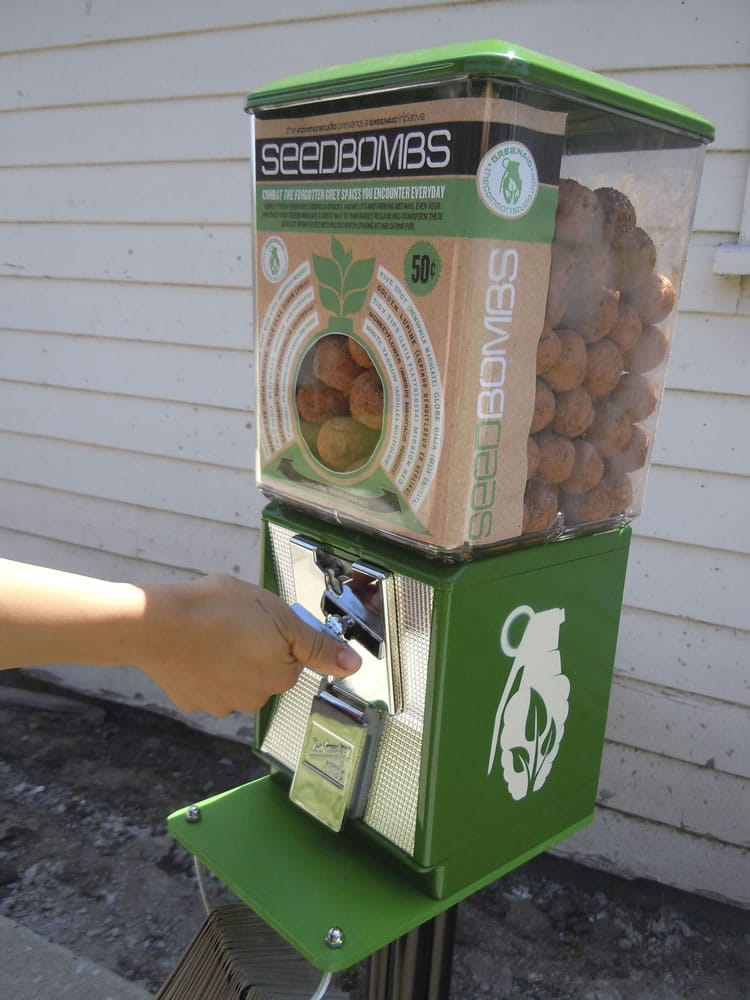Homemade “seed bombs” are a favorite tool of guerrilla gardeners.
Since the early 1970s, these latter-day Johnny Appleseeds have been lobbing the clay-wrapped, compost-rich spheres onto unsightly vacant lots, into alleyways or around sidewalks, where they’ve exploded into bloom.
Thanks to new vending-machine distribution, the small, slow-release seed transporters are also bursting into flower in suburban window boxes, on highway medians and along eroded gullies.
“Put in two quarters, turn the crank and you get a seed bomb,” said Daniel Phillips, an environmental designer who inherited some old candy machines, converted them into seed dispensers, and is merchandising their spread from San Diego to New York, mostly around college campuses and community gardens.
As a result, Phillips said from his Commonstudio office in Culver City, Calif., seed-bombing has “gone from an outdated perception of nocturnal characters coming out in the middle of the night to dig, to traditional gardeners spreading them around problem areas.
“Kids, in particular, like to operate the machines and watch the things grow,” he said.
Planting with seed bombs is more effective than broadcasting seed over the ground, said Josie Jeffery, author of this year’s “Seedbombs: Going Wild With Flowers” (Leaping Hare Press).
“Most seeds are very light and there is risk of them being blown away by the wind, making them unsuitable for launching long distances,” she writes. “The compost and clay act as a carrier so they can be launched over walls or fences and into inaccessible areas.”
The guerrilla garden movement got its start in the early 1970s, when eco-activists began turning blighted or abandoned properties into productive and attractive areas to be enjoyed by the entire community, Jeffery said. Seed bombs became a fun and gentle form of dispersing seeds and beautifying those sites, many of which were fenced or difficult to access.
Guerrilla gardening is generally anonymous since so much of it is done without permission and on property owned by others.
“Your aim is wrong if you are launching seed bombs to be antagonistic, or using them as a form of vandalism or coercion,” Jeffery said. “It is also wrong if you have not given consideration to the plant and its new environment.”
Seed bombing can beautify blighted spaces but it also can cause undesirable side effects, warned Vincent Lazaneo, a home horticultural adviser with the University of California Davis Cooperative Extension.
“There are trespass issues,” Lazaneo said. “It can introduce invasive plants into native habitat. Clearly there are some plants you don’t want out here, particularly flowers that dry out and become fuel for wildfires.”
Seed bombs are easy to make, Jeffery said.
“Homemade compost, humus, green manure, and tea and coffee waste can be used, as well as natural binding materials like waste paper pulp and clay,” she writes. “The compost offers nutrients for the seeds to germinate and grow strong during their infancy, and the clay binds the seed bomb, making it hard enough not to break when it hits the ground.”
Seed bombs can be tailored to specific sites, climates and needs.
“What we’re looking for is low cost and short-term use,” said Phillips, who has formulated mixes for every state in the nation. “Edible plants, too, and something for birds and butterflies. We even have a few that can be used to clean up polluted sites with plants suited for removing toxins and heavy metals.”
Here are some common-sense do’s and don’ts for seed-bomb use:
• Launch them at the right time of year for optimum growing conditions.
• Use the right seeds in the right locations.
• Don’t throw them into neighbors’ gardens without their consent. And don’t use them in agricultural or sensitive natural areas where they could overpower edible or native plants.



